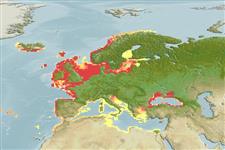Environment: milieu / climate zone / depth range / distribution range
Ecologia
marinhas; Água doce; estuarina demersal; pH range: 7.5 - 8.2; catádromo (Ref. 51243); intervalo de profundidade 1 - 100 m (Ref. 35388). Temperate; 5°C - 25°C (Ref. 13614); 72°N - 30°N, 32°W - 45°E (Ref. 54704)
Eastern Atlantic: coastal and brackish waters of western Europe and from the White Sea to the Mediterranean and the Black Sea (Ref. 4705, Ref. 51442). Introduced into the USA and Canada accidentally through transport in ballast water (Ref. 1739). Asia: Iran (Ref. 39702).
Length at first maturity / Tamanho / Peso / Idade
Maturity: Lm 22.4, range 14 - 30 cm
Max length : 60.0 cm TL macho/indeterminado; (Ref. 35388); common length : 50.0 cm TL macho/indeterminado; (Ref. 30578); peso máx. Publicado: 2.9 kg (Ref. 104349); Idade máx. registada: 15 anos (Ref. 3944)
Espinhos dorsais (total): 0; Raios dorsais moles (total): 53-62; Espinhos anais 0; Raios anais moles: 37 - 46. Flatfish, its disc width less than half its length (Ref. 3137). Small mouth (Ref. 3137, Ref. 51442). Eyes mostly (70%) on right side (Ref. 3137, 51442), 79% of dextrally oriented flounder (n = 1076) in Bos, 2000 (Ref. 57574). Rough skin, especially along the lateral line and the basis of the dorsal and anal fin (Ref. 3137). Lateral line straight, slightly rounded over pectorals (Ref. 3137). Green-olive colored (Ref. 51442), the bottom side white (Ref. 3137). Irregular reddish spots on the eye side (Ref. 35388).
Migratory fish, which is most of the year found in estuaries (Ref. 51442). Adults occur on mud and sand bottom in shallow water, at sea and brackish; often entering freshwaters (Ref. 59043). During winter, adults retreat to deeper, warmer waters, where they spawn in spring (Ref. 30193). The growing larvae are moving to the coast (Ref. 51442). Larvae and early juveniles use selective tidal transport to migrate upstream rivers (Ref. 57575) using a range of triggers such as salinity, prey density and water temperature (Ref. 57573, 57574). Juveniles live in shallow coastal waters and estuaries (Ref. 57574), which are also the summer feeding grounds for the adults (Ref. 30193). Juveniles of less than a year old feed on plankton and larvae of insects, juveniles of more than a year and adults feed on benthic fauna (Ref. 51442), including small fishes and invertebrates (Ref. 30193). Nocturnal and burrowing (Ref. 30193). Marketed fresh and frozen; can be steamed, fried, boiled, microwaved and baked (Ref. 9988). Worms and mollusks are excellent baits for line fishing (Ref. 30578).
Spawns in the water column (Ref. 7471). Produces 400,000 to 2,000,000 eggs for each female (Ref. 51442).
Vinnikov, K.A., R.C. Thomson and T.A. Munroe, 2018. Revised classification of the righteye flounders (Teleostei: Pleuronectidae) based on multilocus phylogeny with complete taxon sampling. Molecular phylogenetics and evolution, 125:147-162. (Ref. 122998)
Categoria na Lista Vermelha da IUCN (Ref. 130435)
Ameaça para o homem
Harmless
Utilização humana
Pescarias: espécies comerciais; Aquacultura: experimental; peixe desportivo: sim
Ferramentas
Relatórios especiais
Descarregue XML
Fontes da internet
Estimates based on models
Preferred temperature (Ref.
123201): 7.2 - 14.2, mean 10.2 °C (based on 862 cells).
Phylogenetic diversity index (Ref.
82804): PD
50 = 0.7500 [Uniqueness, from 0.5 = low to 2.0 = high].
Bayesian length-weight: a=0.00759 (0.00672 - 0.00857), b=3.07 (3.03 - 3.11), in cm total length, based on LWR estimates for this species (Ref.
93245).
Nível Trófico (Ref.
69278): 3.3 ±0.2 se; based on diet studies.
Generation time: 4.4 (3.1 - 5.5) years. Estimated as median ln(3)/K based on 13
growth studies.
Resiliência (Ref.
120179): Médio, tempo mínimo de duplicação da população 1,4 - 4,4 anos (K=0.22-0.3; tm=2-5; tmax=15; Fec= 2 million).
Prior r = 0.56, 95% CL = 0.36 - 0.86, Based on 5 stock assessments.
Fishing Vulnerability (Ref.
59153): Moderate to high vulnerability (49 of 100).
Climate Vulnerability (Ref.
125649): Moderate vulnerability (36 of 100).
Nutrients (Ref.
124155): Calcium = 33.1 [14.0, 58.0] mg/100g; Iron = 0.26 [0.13, 0.49] mg/100g; Protein = 17.8 [15.6, 19.8] %; Omega3 = 0.322 [0.161, 0.627] g/100g; Selenium = 14.7 [7.4, 32.3] μg/100g; VitaminA = 6.9 [1.9, 26.1] μg/100g; Zinc = 0.509 [0.347, 0.750] mg/100g (wet weight); based on
nutrient studies.
